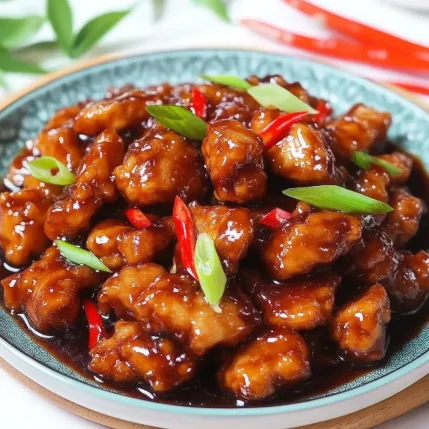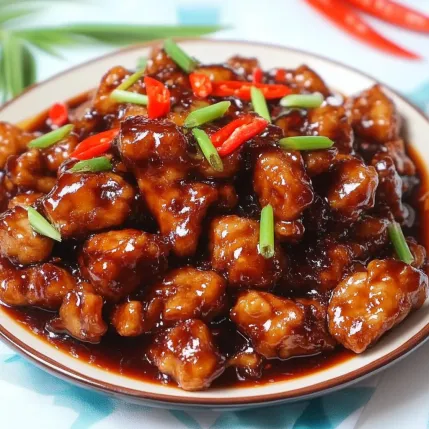 Bookmark
Bookmark
Sticky Mongolian chicken hits the perfect balance of sweet and savory with just the right amount of gloss and bite. It’s one of those weeknight meals that feels a little indulgent but comes together in no time. Served over rice or noodles, it becomes an instant favorite that brings restaurant-style flavor straight to your kitchen.
I first made this dish on a whim after a long workday and was amazed how fast it came together. Now it’s a go-to when I need something reliable and satisfying.
Ingredients
- Boneless chicken breast or thighs: cut into bite-sized chunks offers a juicy and tender base
- Cornstarch: creates that crisp outer coating and helps the sauce cling beautifully
- Soy sauce: provides the salty umami core of the sauce
- Brown sugar: brings rich caramel notes and balances the salty tang
- Garlic and ginger: add warmth and aromatic depth
- Vegetable oil: is neutral and perfect for high-heat cooking
- Scallions: give a fresh sharp bite at the end
- Cooked rice or noodles: make the dish a full meal and soak up every drop of the sauce
Look for chicken that’s firm and pink without excess liquid. For soy sauce go with a low-sodium option if possible to better control the seasoning.
Step-by-Step Instructions
- Sear the Chicken:
- In a bowl coat the chicken chunks evenly with cornstarch making sure all sides are lightly dusted and no clumps remain
- Cook the Chicken:
- Heat vegetable oil in a large skillet over medium high heat. Add the coated chicken and cook undisturbed for two minutes to develop a crust. Stir and continue cooking for about six minutes until golden and cooked through. Remove from pan and set aside
- Mix the Sauce:
- In a separate bowl whisk together soy sauce brown sugar minced garlic and ginger until smooth. The mixture should be syrupy and fragrant
- Simmer the Sauce:
- Return the pan to medium heat and pour in the sauce mixture. Let it bubble and reduce for three to five minutes until thickened enough to coat a spoon
- Coat the Chicken:
- Add the cooked chicken back into the pan and stir well so each piece is glossy and coated with the sauce. Let it simmer another minute for everything to come together
- Plate and Garnish:
- Serve hot over cooked rice or noodles. Sprinkle sliced scallions on top for a fresh finish
 Bookmark
Bookmark
Ginger is my favorite part of this dish. It wakes up the sauce with just enough sharpness to balance the sweetness. My youngest always asks for extra sauce which I secretly double every time.
Storage tips
Store any leftovers in an airtight container in the fridge for up to three days. Reheat in a skillet with a splash of water to loosen the sauce and bring it back to life. The flavor deepens as it rests
Ingredient substitutions
If you don’t have brown sugar try using honey or maple syrup for a slightly different but still delicious result. Tamari or coconut aminos work well if you need a gluten free option
Serving suggestions
Serve with steamed broccoli or snap peas to balance out the richness. Jasmine rice or lo mein noodles pair beautifully and soak up the sauce
 Bookmark
Bookmark
Cultural context
Mongolian chicken is a Western take on Chinese American cuisine. Despite the name it’s not traditionally Mongolian but it’s inspired by the bold soy based sauces popular in Chinese style stir fries
Frequently Asked Questions About Recipes
- → Can I use chicken thighs instead of breast?
Yes, chicken thighs work well and offer a juicier texture. Boneless, skinless thighs are ideal for even cooking and easier bite-sized pieces.
- → How do I make the sauce thicker?
Let the sauce simmer gently after adding it to the pan. The brown sugar helps it naturally thicken, but you can also mix in a cornstarch slurry if needed.
- → What vegetables pair well with this dish?
Broccoli, snap peas, bell peppers, or bok choy make great additions. Stir-fry them briefly before adding the sauce for a balanced texture.
- → Can I make it ahead of time?
Yes, the chicken and sauce can be prepared ahead and stored separately. Reheat gently and combine just before serving to maintain texture.
- → Is this dish spicy?
No, it's more sweet and savory than spicy. For heat, you can add chili flakes, sriracha, or a touch of gochujang during cooking.
